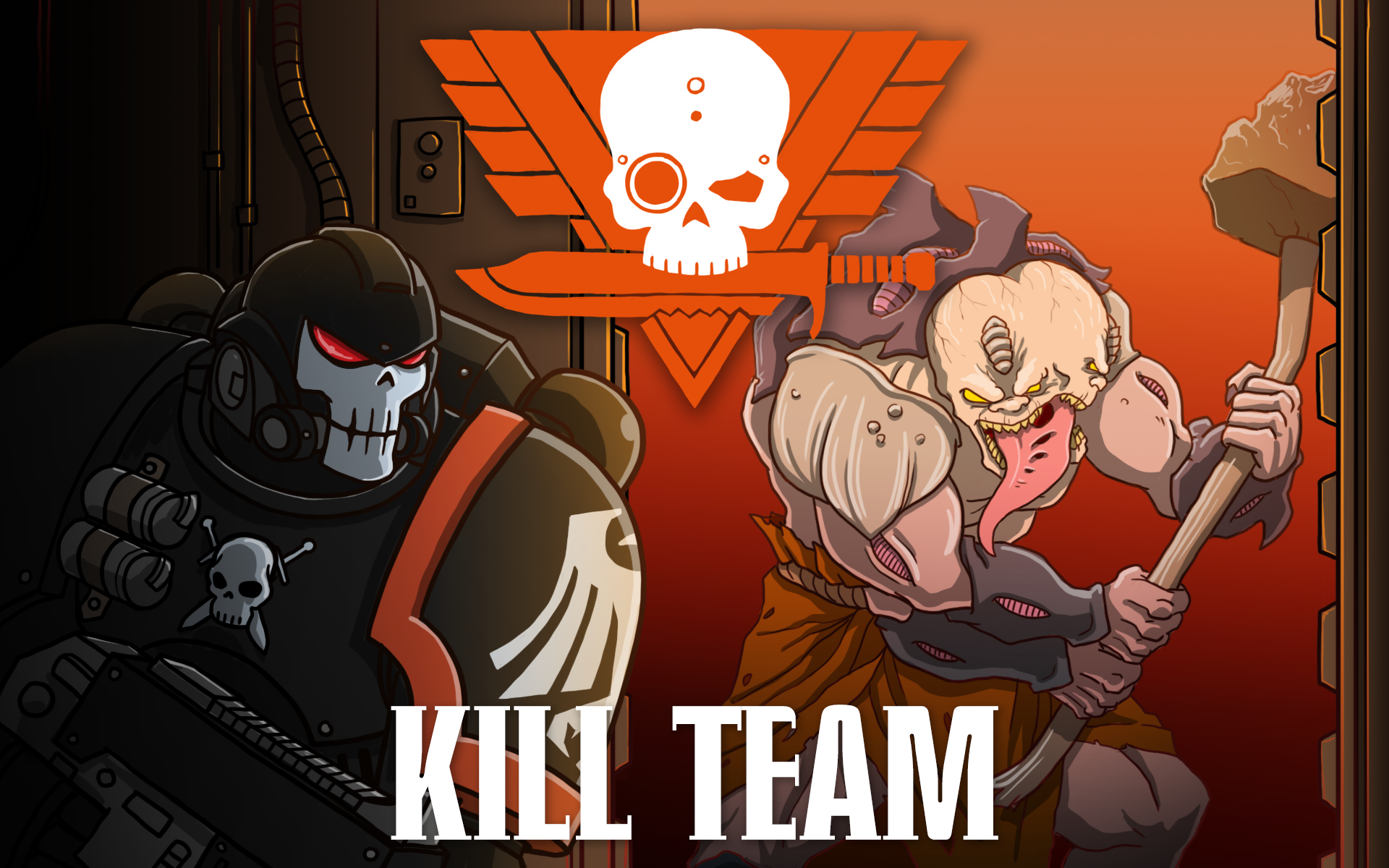Adeptus Astartes Kill Teams
Better known by their GW-Tried-To-Trademark-This-But-Lost-In-Court name, the Space Marines. These are the poster boys for 40k. They’ve been showing up as models for 30 years, they’ve had good video games, dozens of books and they’re even sneaking into fantasy as Sigmarines. We’ve put it off for long enough with our discussions of Eldar and Chaos Space Marines and Custodes and Imperial Guard. In today’s article I’ll talk about using building, playing, and going up against Space Marines competitively in Kill Team.
Strengths
- Lots of Silver Bullets – Marines have really solid options in every category, and pretty much have answers for any problem. They’re sometimes expensive or limited, but Marines can kit out to be horde clearers, assassins, power armor killers, melee monsters, etc. Marines have more options than any other Kill Team.
- Tough as Hell – They don’t quite stack up to Custodes or Death Guard, but the weakest marine model is still T4 with a 4+ save, and it’s pretty trivial for Marines to get 3+ invulnerable saves or multiple wounds without spending too many points. They also have Transhuman Physiology, so just pushing through a flesh wound won’t do anything to blunt their effectiveness.
- Good Baseline – Marines are default 3+ to hit in melee and shooting and they can easily get two S4 attacks. That’s not too amazing but it’s enough that even cheap Marine models can threaten hordes.
- Tactics – Marines have some very good faction-specific tactics that make them even more viable.
Weaknesses
- Lack of Cheap Models – Competitive Kill Team pushes missions that need objective sitters. These models don’t actually do anything so the cheaper they are the better, and Space Marines don’t have the 5-7 point models that you can just throw in the back and ignore.
- The Toys are Too Expensive – You get the option to bring Terminators, jump pack Vanguard Vets, Eliminators with Las-fusils and much more, but you generally won’t because they’re too expensive (at least in competitive play). 4-5 model kill teams generally don’t cut it for marines; you want a lot more models on the field and that means sacrificing the cool stuff in order to get more bodies.
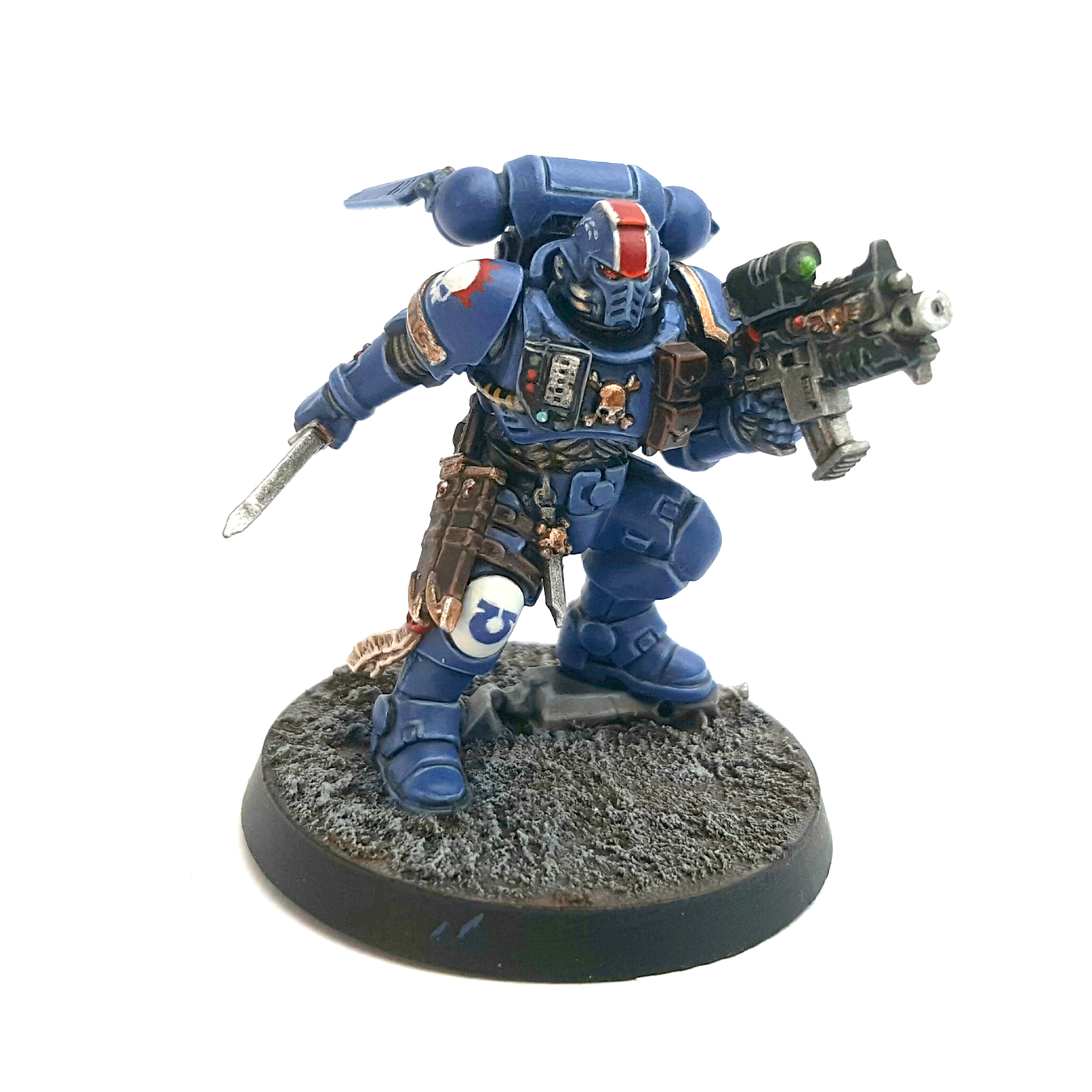
Chapter Tactics
As of the release of Elites, Space Marine Kill Teams can choose a chapter tactic to apply to their team. These vary in power from “not adding much” (Raven Guard) to “extremely good” (White Scars). Note that these don’t cover the specialist marine factions, the Grey Knights and Deathwatch — those are entirely separate factions (We’ve covered Deatwatch already here).
White Scars – Lightning Assault
Add 2″ to your advances, and if an enemy model fell back your models can still charge. Both sides of this are really, really good. The second half makes melee models that don’t one shot enemies more viable, and Kill Team is largely a game of movement so anything that speeds you up is great. This is arguably the best Chapter Tactic. A+
Salamanders – Master Artisans
Reroll a single failed Hit and a single failed wound roll in each phase. This can more or less be 6 rerolls a turn if you play it well, which is quite good. Competitive play doesn’t reward killing that heavily, but it’s still the most generically powerful Chapter Tactic. A
Imperial Fists – Siege Masters
Add 1 to injury rolls if the opponent is benefitting from cover. If you expect to do your killing at range this is the best Chapter Tactic. B+
Black Templars – Righteous Zeal
Re-roll charges. This only really empowers a single build, but it’s a simple and effective trait. B
Iron Hands – The Flesh Is Weak
Gives all of your models a 6+ Feel No Pain roll. It’s always nice, but it does less to make your plan happen than it prevents an enemy plan from happening. C
Ultramarines – Codex Discipline
Your team has +1 leadership, and if they fall back or retreat they can still shoot to hit on a 6+. Marines don’t generally have leadership issues and hitting on a 6 makes the other half of the trait mediocre. It’s not actively bad but it doesn’t do a lot for most teams. D
Raven Guard – Shadow Masters
If you’re 12″ away from an enemy you have cover against them. This is good in 40k because the board is big and the cover rules are restrictive. Kill Team boards are small and if you’re at long range the generous cover rules probably already have you hidden. Most of the time this is pretty useless. F
Dark Angels – Grim Resolve
If you didn’t move, you can re-roll 1’s to hit in the shooting phase. Also, you can re-roll the dice to determine whether your team is broken in the Morale phase. Kill Team is a game of movement so the shooting ability won’t come up as often as you like but if you’re using it on 1-2 models with plasma then it’s giving you a real benefit. Dark Angels are also a non-codex chapter, which means that they get extra units. They have special terminator and veteran options, but these mostly end up being a drawback since they can’t take sternguard or vanguard veterans. The morale bonus is very situational, but can come in handy in a pinch. C+
Blood Angels – Red Thirst
If you charged or were charged, you add +1 to wound rolls in melee. They also have two extra pistols, the inferno pistol (basically a meltagun, and expensive) and the flame pistol. The main benefit there is that the flamer pistol is free, which opens up some neat 13 point vets with two flamer pistols that fight well against hordes. B
Space Wolves – Hunters Unleashed
If you charged or were charged, you ad +1 to hit rolls in melee. This is usually worse than the Blood Angels version but it’s nice with power fists or wounded models. The more important thing is that Space Wolves have some very different terminator and veteran options, most notably the ability to take Jump Packs on regular vets, which lets them take Jump Packs and special weapons. B+
Adeptus Astartes Special Rules
All of models available to Space Marine Kill Teams have the following generic rules:
Transhuman Physiology
Space Marines ignore hit penalties from the first flesh wound. Without Death Denied it isn’t something you can rely on, but with it you play aggressively with your offensive threats and still have them be threatening. Even without certainty it’s a nice benefit and helps you kill in the later phases.
And They Shall Know No Fear
Re-roll failed nerve tests. Between this, the relatively high leadership and the low model count of marine teams morale isn’t usually a problem for Marines.
Adeptus Astartes Units
I’m not going to break every data sheet out into its own section here. There are quite a few data sheets that should be separate and some that only have minor differences. I will cover all of the important units in turn. If you’re looking for more detail on some of the newer units that were added, check out our review of the White Dwarf article that introduced new Vanguard marines to Kill Team here.
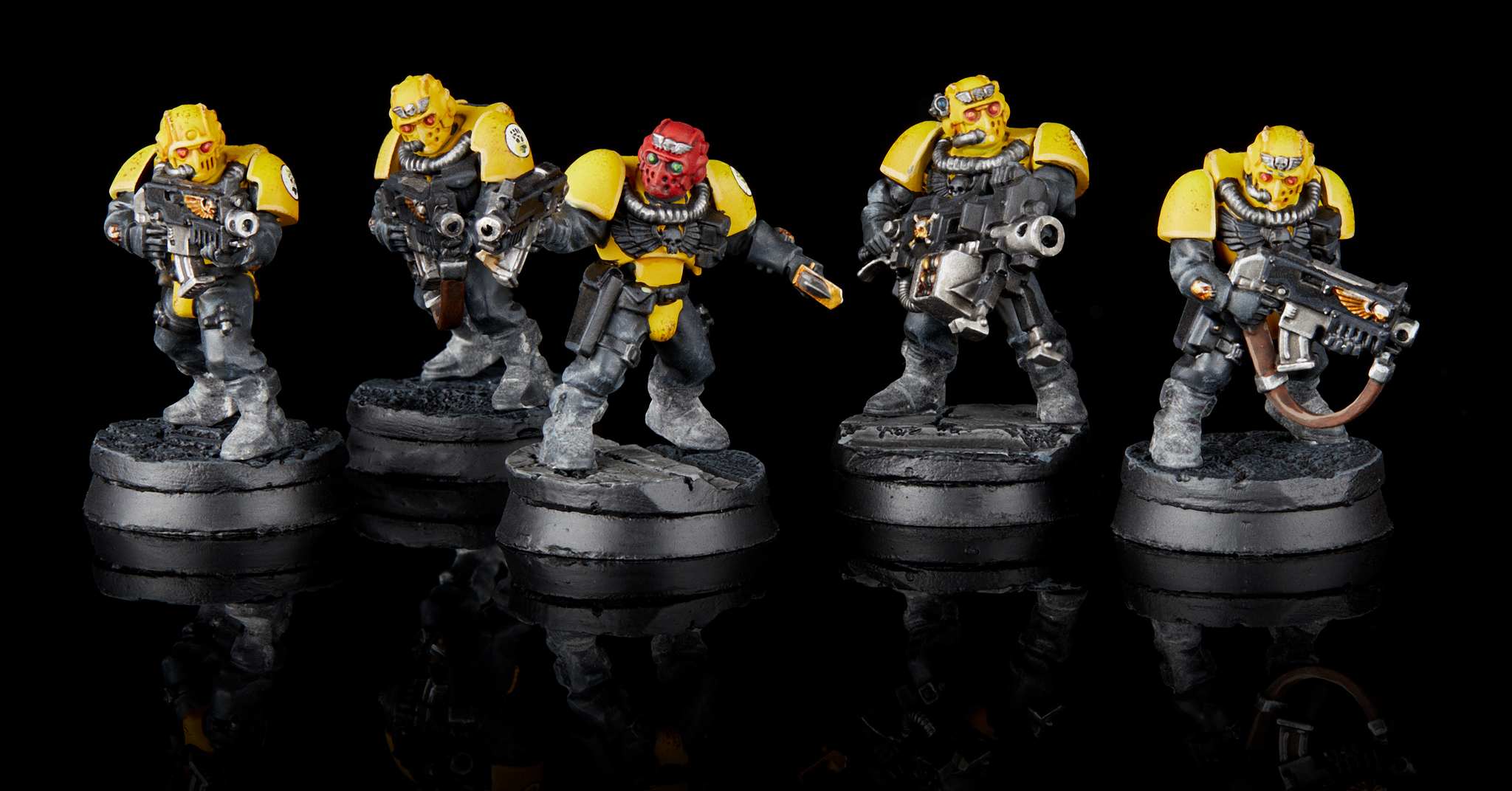
Scouts
Scouts are the backbone of a competitive Space Marine kill team. They’re not quite as tough defensively as a normal marine but they’re still tough enough that common weapons like lasguns or bolters don’t reliably injure them, and they don’t give up much offensively. The Bolter, Combat Knife and Astartes Combat Shotgun weapon options are all viable, and each fills a different niche. The bolter is great for backline objective holders with the long range, the combat knife is good for holding objectives up front where you might get into melee and the shotgun gives you a bit of maneuverability. There’s also a sniper rifle/camo cloak option but you end up paying extra for something that doesn’t really make the model more effective.
The heavy weapon options are both viable. 14 points for a heavy bolter or 16 points for a missile launcher are both a steal when you’re targeting a 7 man (14 points per model) or 8 man (12 points per model) team.
The Scout Sergeant option is very common as a competitive choice. For one point you get the extra attack and leadership, but the important thing is that he’s a cheap leader you can stick in the back and not feel too bad about. Leaders are resources you protect so you don’t want to bling them out with lots of extra wargear that won’t get used.

Power-Armored Firstborn (Small Space Marines)
These are all of the one wound, 3+ save models. For 12 points you can get a regular marine, or for one point more you can get a veteran that’s just better in every way. Take the vets, except for a Tac Marine Plasma Gunner. Due to changes in the cost of Plasma for Elites, he’s two points less than a comparable company vet with a plasma gun which is enough of a discount to make him worthwhile.
Now that that’s out of the way, let’s dive into the Veterans data sheet. The first (and second, third, and probably fourth) time you read it it’s just an unholy mess of gibberish. After you’ve had a few drinks and the headache has gone away, it’s pretty simple. All of the vets have two slots for weapons, and they can do a series of swaps to put different weapons in those slots.
Sternguard start with an improved bolter (AP-2, 30″ range) and a bolt pistol. They can swap out the Special Issue Bolter for a combi-weapon, which includes storm bolters. There’s nothing particularly wrong with this, but the bolt pistol is a little useless so Company Vet options with a similar weapon and a chainsword are a bit better. There’s also a gunner option that lets you replace the bolter with a heavy weapon, which has an expanded set of options. The stand-out heavy weapon is the Grav-Cannon, which is absurdly good against power armored factions and still reasonable against the ret of the field, but a lot of the other options had point increases in Elites that make them hard to stomach. The Sergeant works best as a combat character since he can fill two slots and still take his special issue bolter. A Bolter and two chainswords gives you five attacks at 15 points while keeping the improved ranged weapon, and more expensive melee options like power fists can be worth it.
Vanguard Veterans fill their two slots with melee weapons or pistols (incidentally a Storm Shield is a melee weapon here), and they can optionally take Jump Packs and melta bombs. The best builds revolve around cheaper weapon options or dual pistols. Two chainswords gives you 4 attacks at 13 points and makes for a good front-liner against armies without a good armor save. Dual Lightning Claws are another good option since you go up to 3 attacks with a high quality weapon that threatens models with higher toughness or power armor. Power swords, axes and mauls are generally inferior to a single lightning claw and heavier weapons like power fists aren’t really worth it on a 2 attack model. Dual pistol builds are good because you can shoot both pistols, the pistols tend to be reasonably priced (two plasma pistols are less than a plasma gun, grav pistols are a point each, hand flamers are free) and the model is still competent in melee with two attacks and pistol shots if they stay in melee. Jump packs are very good, but they’re also expensive and you need to have a plan for them. If you don’t have a plan I wouldn’t bother taking them. Vanguard Sergeants are mostly interesting because they can access Relic Blades, which are pound for pound one of the best melee weapons in the game.
Company Veterans are a bit more generalist. They have most of the same options as Vanguard Vets (no jump packs or melta bombs, though), but they can also take a bolter, combi-weapon or special weapon and a melee weapon or pistol. You can’t double up with the pistols so they’re a bit weak but you can pair one of the cheaper options like Grav Gun (2 points), Storm Bolter (2 points) or Flamer (3 points) with a chainsword and have a cheap vet with an effective ranged weapon and 3 attacks in melee. You can also grab a storm shield and bolter for a cheap rock to anchor the rest of your team. The Sergeant here is just a +1, he gets three weapons and an extra attack but otherwise doesn’t have any special options.
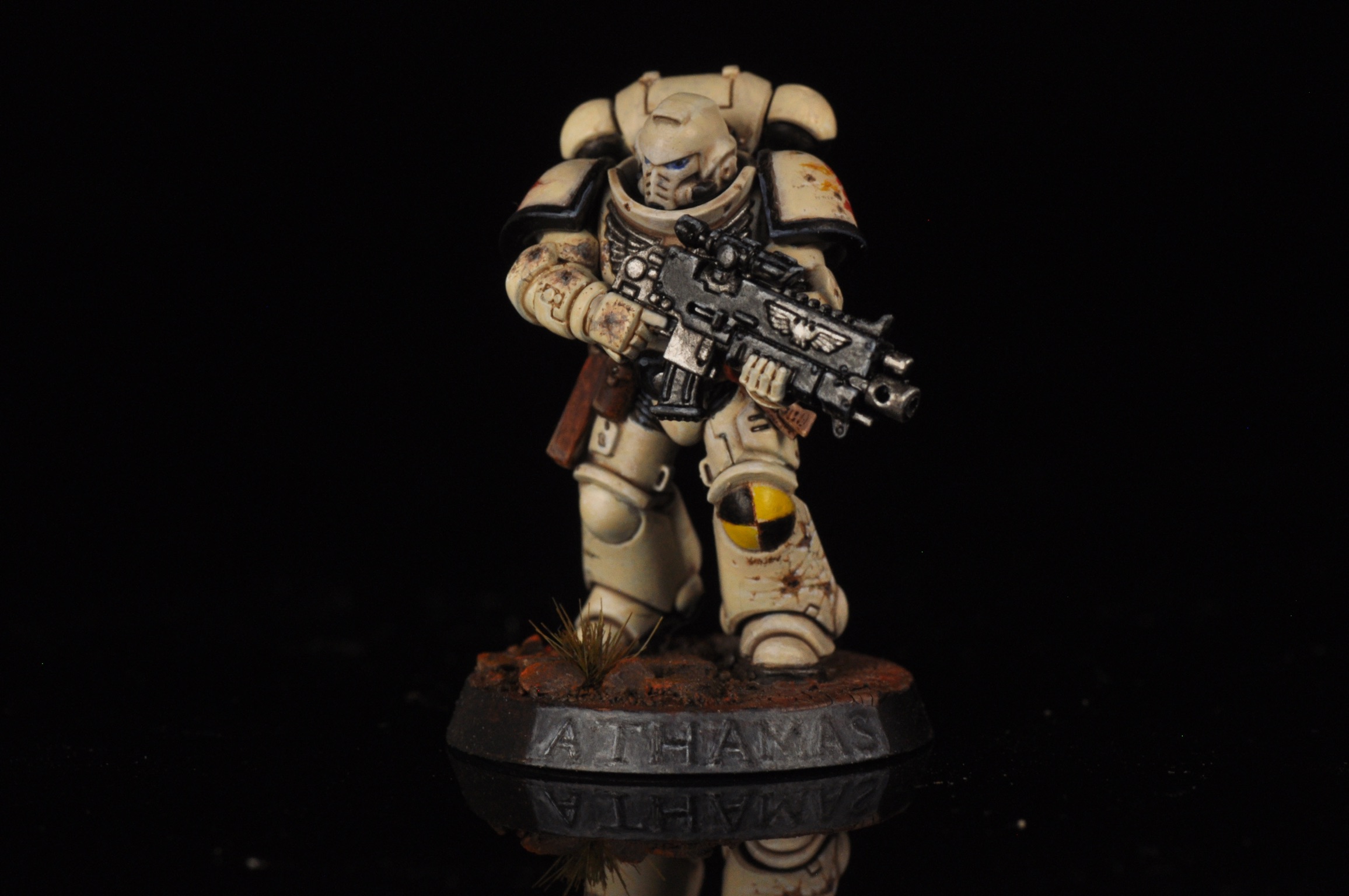
In***ors and Reivers
Incursors, Intercessors, Infiltrators and Reivers. These are all 2 wounds, 2 attacks with a slightly improved bolter. I talked more about them here, but I’ll repeat a bit.
- Intercessors are the cheapest and have the most options. The Auxiliary Grenade launcher is solid, the Auspex is great on a Comms Intercessor and Sergeants with Power Fists are absolute beasts. With the old weapon stats still in play the Bolt Rifle is the best choice but that may change.
- Incursors pay an extra point for a bolter that’s better at killing stuff in cover and they have a slightly improved melee attack.
- Infiltrators get to deploy outside of your deployment zone and they force enemy deep strikers to come in further away.
- Reivers get to deep strike, have extra movement options that they can pay for and can take a combat knife for an extra melee attack.
Intercessors are pretty good, any of the others can be good if you understand why you’re taking them. Remember that if the enemy is shooting you with multi-damage weapons these .aren’t any tougher than vets.
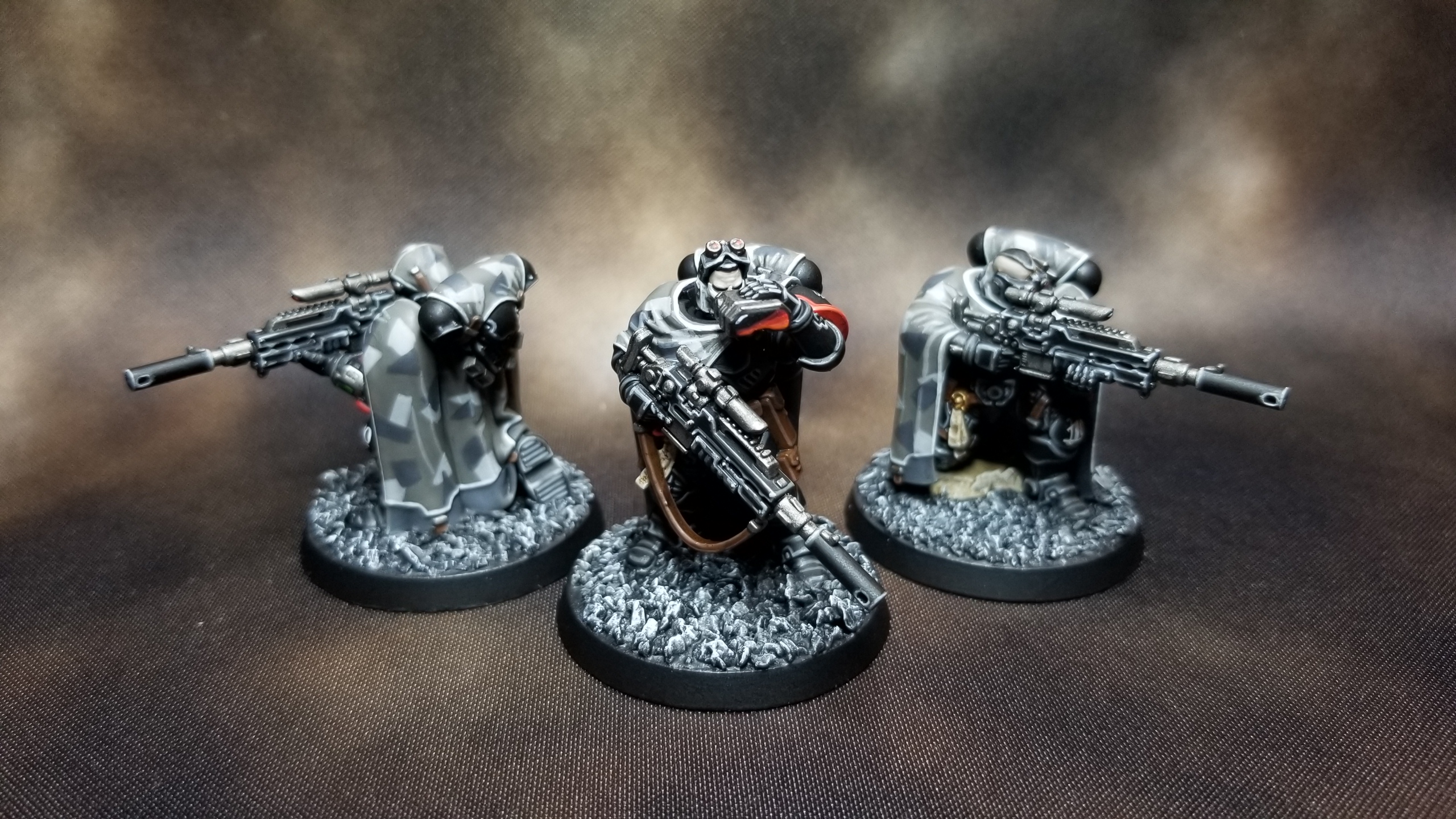
Eliminators
These almost fit in the last section, but they’re different enough from the other Primaris troops that they deserve their own section. Take an intercessor, give him a sniper rifle, camo cloak and three more points out of your budget and you’ve got an Eliminator. They’re still Primaris tough (plus the camo cloak, which gives an extra -1 to hit when you’re in cover) and have two attacks so they can mix it up reasonably well in melee, and the sniper rifle they get does some work. It was recently buffed from strength 4 to strength 5 which is enough to make it generally effective. Mortis rounds (AP-1, +2 to hit, can shoot without Line of Sight and hit on 6’s) keep eliminators accurate on the move since the +2 to hit offsets both the move penalty and cover. Executioner Rounds (AP-2, D3 damage, deals a mortal wound on a wound of 6) represent a serious threat if there’s comms or auspex support since you’ll generally be hitting on 2’s, wounding on 3’s and punching through armor 2/3 of the time or better, and D3 damage creates very dangerous injury rolls. Hyperfrag Rounds (D3 shots, no AP) just aren’t good compared to the other options. Eliminators also have concealed positions so you can set them up in an advantageous position.
Eliminator Sergeants are a reasonable choice for your leader since they’re tough for the points and they can actually get some work done from the back line. Just remember that you’re unlikely to give them comms/auspex support so you can’t really rely on the Executioner Rounds to hit.
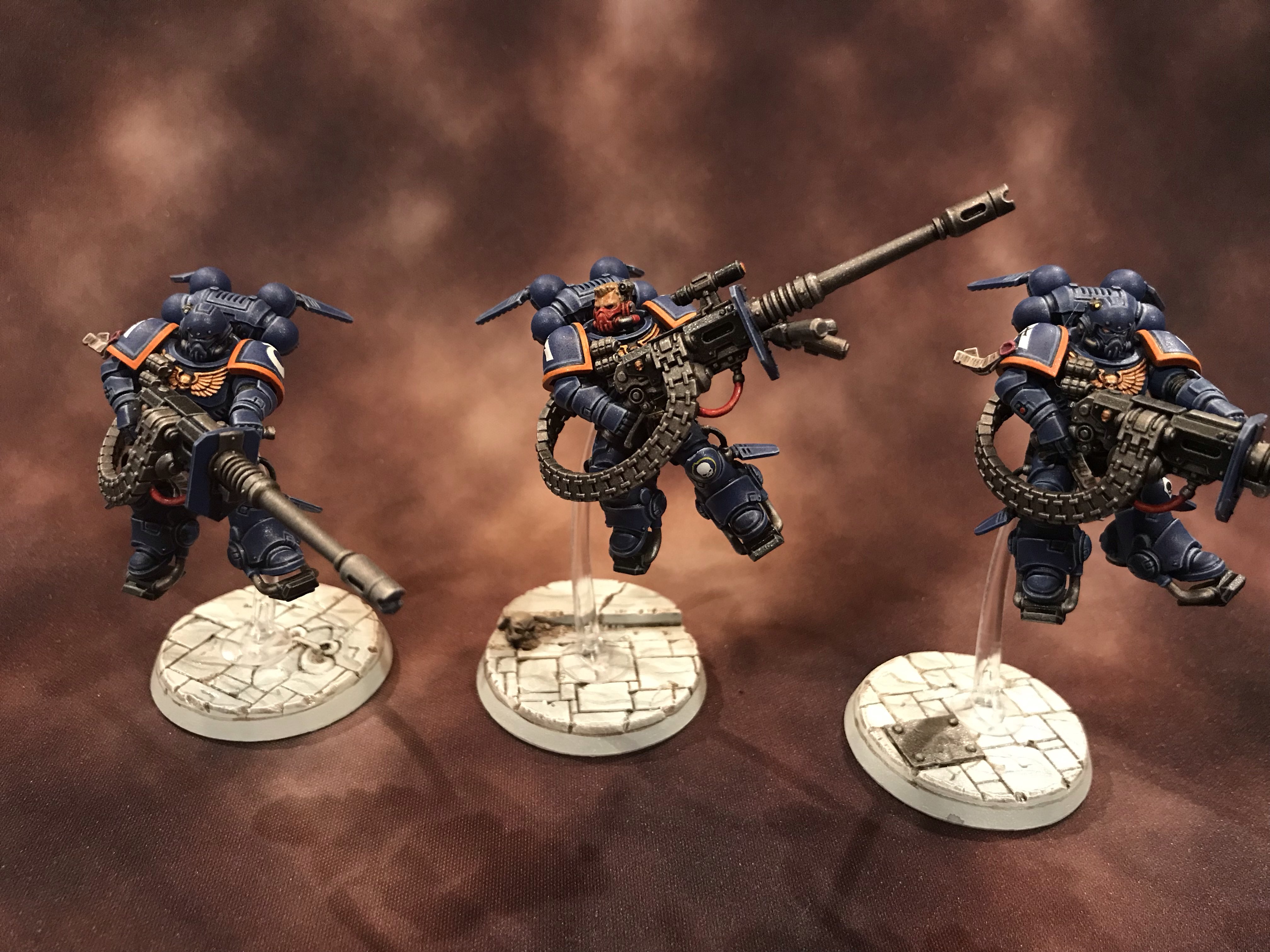
Suppressors
Remember what I said about Executioner Rounds for Eliminators? The Accelerator Autocannon is all of that but better, and twice the shots. Suppressors lack the camo cloak so they’re a little easier to kill at range, but they have 12″ movement with fly to make it easier for them to get into cover or get a better angle and they’re much harder to tie up in melee. The gun itself is everything you want in kill team. Wounds everything on a 3+, cuts through quite a bit of armor without overspending, and 2 damage means that you’ve got a 55% chance of a successful injury roll vs an enemy in cover and 75% without the cover. The extra ability that prevents enemies within 2″ of a wounded enemy from shooting that turn can also give a huge advantage against a shooting faction. At 29 points it’s a serious commitment but if used properly it can take over games.
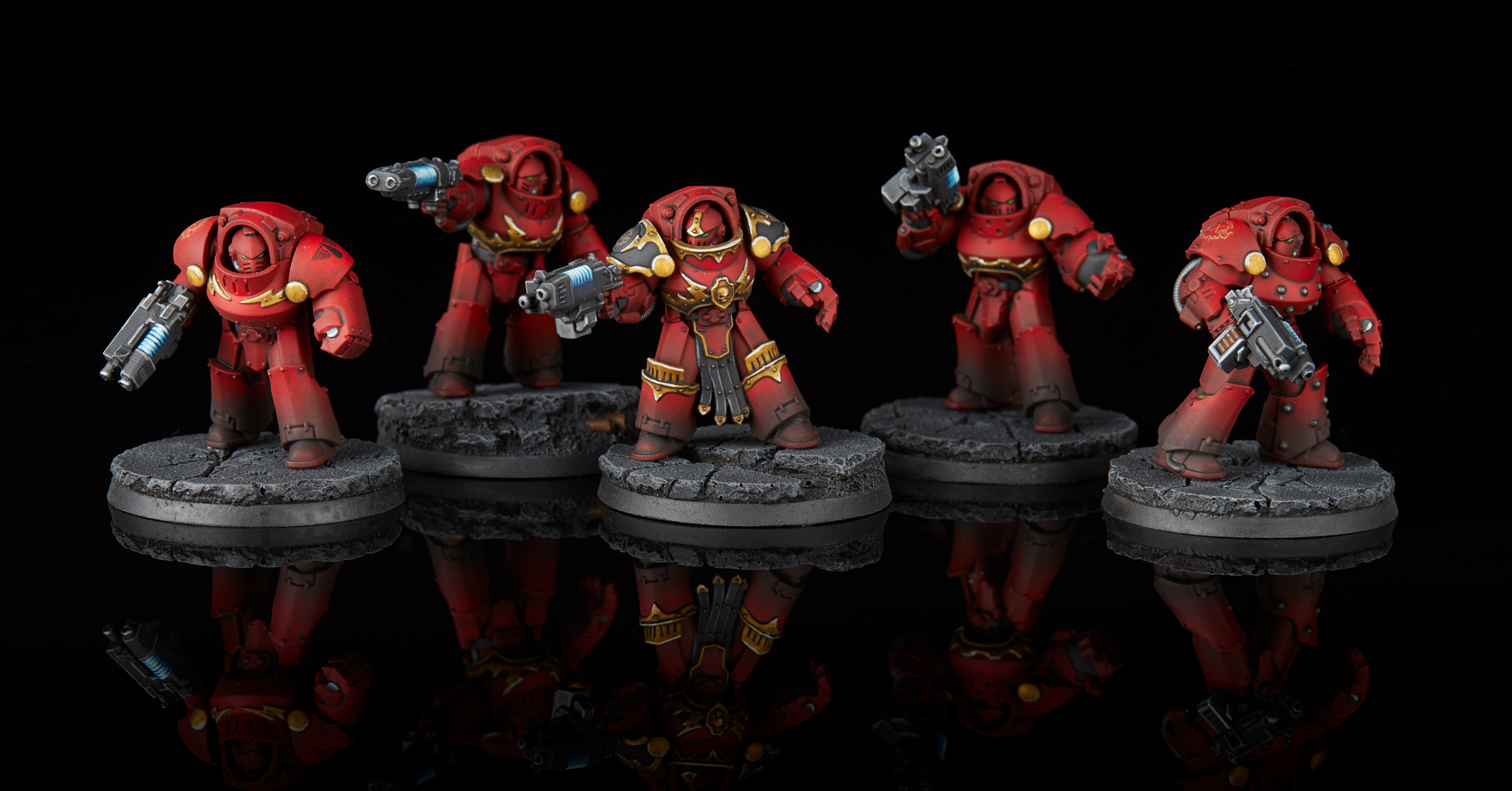
Terminators
Terminators are really cool. They teleport, they can take a bunch of cool weapons and they’re pretty tough. Unfortunately, that isn’t quite what you usually need in more competitive games. If you really want to play with some cool models or you think you’ve found a matchup where the elite nature of Terminators gives you an advantage, there’s a couple of things to keep in mind. First, Terminator Armor is tough, but it’s not that tough. You can ignore bolters and chainswords, but even Heavy Bolters or Krak grenades can seriously threaten you and Plasma Guns or Power Fists really don’t care much at all about your armor.
Secondly, you want weapons that can make an impact. That means high quality (strength 5+, some AP) and either a bunch of attacks (assault cannons, lightning claws) or multiple points of damage (Cyclone Missile Launchers, Thunder Hammers, Power Fists). You also need the right targets, if you’re up against Death Guard you need to be killing Plague Marines, not Poxwalkers or you’ll never make back the points. Mixing ranged weapons like Assault Cannons or Heavy Flamer and combat specializations can also work out since all Terminators have a good melee weapon. Space Wolves can also take a broader range of options and can make some interesting builds.
Commanders
I’ll preface this section by saying that Commanders are usually not played competitively. In general the two best options are cheap strategists or psykers if you want to win, but if you’re having fun the Rambo options can be fun and are still viable. Everything here more or less does what it should.

Lieutenants
These are the budget options, and the most competitive if taken as strategists. You can either take a two damage gun or a regular power sword, but neither will make back the points easily. These models act as a CP generation resource more than killers, so you’re best off taking the rifle to give them something to do. You can also give them phobos armor for the ability to deep strike, but that prevents you from gaining the Strategist CP first turn.
For 1 CP you can reroll wounds of 1 for friendly models within 6″ of this model.
Captains
These are models that look good until you see the weapons. 6 wounds at 3+/4++ is pretty tough, and the WS 2 BS 2 profile with 5 attacks base looks like it should be scary. Damage 2 Bolt Weapons and damage 1 power swords just don’t make this into a particularly scary commander. You can take it as a Strategist, but he doesn’t do much more there than an LT would have. The Phobos upgrade doesn’t do much to help, you get a slightly better gun but lose the power sword, and you can a few extra rules like Concealed Positions and Omni-Scrambler. The Terminator Armored Captain actually fixes a lot of these issues. He’s not exactly efficient but you can take options like Storm Shields, Relic Blades, Power Fists and Combi-Weapons that can give him durability, killing power or the ability to reach out and touch weaker enemies.
For 1 CP a Captain can give a 6″ aura that lets friendly models reroll 1’s to hit.
Chaplains
Chaplains are the efficient melee Commanders for Marines. Both variants get a reasonable melee weapon. At S5 AP-1 D2 the Crozius Arcanum hits reasonably hard and will reliably take enemies out of action, and four attacks without any specialism lets it fight a mob. The 4++ from the Rosarius keeps the Chaplain safe from power powerful weapons, and the Absolver Bolt Pistol is a competent ranged weapon. The Terminator upgrade gives a 2+ save, gives the Chaplain a better set of ranged weapon options and most importantly gives access to the Teleport Strike tactic, but it does sacrifice a melee attack.
Chaplains have two special tactics. The first gives a re-roll aura that lets all friendly models within 6″ re-roll all failed hits in the fight phase. The second lets friendly models within 6″ use the Chaplain’s leadership instead of their own.

Librarians
Librarians are the Psyker Commanders for Marines. They get power swords that are D3 damage so they’re pretty good in melee, but the real strength is their Psychic powers. Their Psychic Hood gives them +1 to deny enemy Psychic powers, and they can cast two powers and deny 1 each turn. They have the standard selection that all commanders get, but they also have access to three unique powers. They can also take Terminator armor for a 2+ save and an invulnerable save, as well as the ability to teleport and a better selection of melee and ranged weapons.
Librarius Discipline
- Veil of Time: WC 5 – Until your next psychic phase, a friendly model within 18″ can re-roll charge and advance rolls and always fights in the Hammer of Wrath phase even if they did not charge. This has weird timing problems because it comes into play the next charge phase, but it’s not terrible.
- Might of Heroes: WC 6 – A friendly model in 12″ gets +1 strength, attack and toughness. This is a very serious buff, significantly better than any of the specializations.
- Null Zone: WC 8 – enemy models within 3″ cannot take invulnerable saves. This will absolutely crush some armies like Harliequins or Deathwatch that are relying on Storm Shields, but it will do absolutely nothing most of the time.
There’s also an option for Phobos Armor. This gives a Camo Cloak, which is a significant durability upgrade if you stay at range, and the Concealed Positions ability. It also gives access to the Obscuration Discipline, with the following powers.
Obscuration Discipline
- Shrouding: WC 6 – A friendly Phobos model cannot be targeted unless it’s the closest target. If there were better ranged Phobos models this would be more impressive, but it’s probably best on an Eliminator.
- Hallucination: WC 7 – Subtract 1 from Leadership and Hit Rolls for an enemy model within 12″. There are better powers but it does an ok job in most situations.
- Mind Raid: WC 6 – Deal 1 Mortal Wound to a visible enemy within 18″. If that model was a Commander or Leader, gain a CP. This is pretty good. At worst it’s a targeted Psybolt, and the extra CP is powerful if you can get it.
Other Commanders
There are a number of Rogue Traders or Inquisitors that can also be taken as Marine Commanders. Eisenhorn is interesting if you’re up against Xenos, but the others are more of a “for fun” option. Feel free to take them but they’re usually not amazing.
Adeptus Astartes Tactics
Core Tactics
This includes Tactics printed in the base rule book or Elites. Some tournaments will only allow these tactics to be used.
Death Denied – 2 CP 3 CP
If a model in your team would be taken out of action, it instead takes a flesh wound. This is really, really powerful and it’s a really, really, really good argument for holding CP the entire turn. You still can’t dump your guys into situations where you’ll take 2-3 flesh wounds in a turn, but this lets you be a bit more aggressive with your important models while still guaranteeing value out of the. This is arguably the single best Tactic in the entire game and is a defining ability of Astartes. A+
This was updated to be 3 CP, which changes the math. It’s still a very powerful ability that other factions don’t get but you’re using it at most twice a battle. This might still see some use but you’re more likely to see other tactics used now. C
Death To Traitors – 1 CP
In the Fight phase, a model explodes 6’s to hit into additional attacks. This is just OK, and with the Chaos rider you’ll rarely get to use it. C
Armour of Contempt – 1CP
You can use this tactic when a model suffers a mortal wound. Ignore that mortal wound and any other mortal wounds that phase on a 5+. If you have the extra CP this can be nice, but it’s a lot more reliable to use Death Denied to keep your models alive. C
Masterful Marksmanship – 1 CP
Give an Intercessor with a Stalker Bolt Rifle +1 to hit and wound rolls for a phase. This would be good if Stalker Bolt Rifles were good, but they aren’t. D
Honour the Chapter – 2 CP
One of your models fights again at the end of the fight phase. Marines have enough access to good melee that this tactic can completely change the tide of a battle, and it happens after most enemies would be able to fight back so you don’t have to choose between it and Death Denied. A
Hellfire Shells – 2 CP
Take a Heavy Bolter and it can only shoot once, but if it hits then you do D3 mortal wounds. This is a lot better in Deathwatch where it’s 1 CP, but Adeptus Astartes have easy access to Auspex and Comms, so you can easily boost this to hitting on a 2+. If you have the right assassination target it can be worth it but it’s not good most of the time. C
Shock and Awe – 2 CP
This lets a Reiver throw a Shock grenade before charging, which will turn off overwatch if it hits. You have to start within 6″ of an enemy before a charge and be afraid of the overwatch, which won’t happen that often, and even then you could just Death Denied the overwatch. This probably isn’t ever worth it but somebody might find a situation where it’s good. F
Grav-Chute Descent, Teleport Strike and Jump Pack Assault – 1 CP
These all let you deep strike up to 3 models. Grav-Chutes works for models with Grav-Chutes or Reivers, Teleport Strike for Terminators and Jump Pack Assault works for Jump Pack models. They all do what you’d expect and the effect is powerful in the right situations. Just remember that if you use these, you can’t use Death Denied that turn. B
Angel of Death – 1 CP
Give a model that charged an additional attack this phase. This is one of the better stratagems if you have additional CP, but I’d keep at least 2 CP up for Death Denied unless you’re in the fight phase against Tau or Guard. B
Smoke Grenades – 1 CP
At the beginning of the shooting phase, and Infiltrator or Suppressor Sergeant can throw a smoke grenade that obscures all friendly models within 3″. That model can’t make a shooting attack this turn. Using this strat gives the same feeling as calling up your parents at 3am and opening with “I fucked up Dad”. If you’re using this, you probably should have done something different in the movement phase. D

Box Set Tactics
These tactics were all released in Fangs of Ulfrich. Many tournaments will allow these but many won’t. Check with your TO before the event to make sure you aren’t planning for a strategy you won’t have access to.
Battle-Brothers – 1 CP
You can pass off a failed saving throw onto a friendly model within 6″, and it takes mortal wounds equal to the damage of the attack. This does not cancel the attack sequence so it’s best used on single large hits, and it’s also nice when you can pass the wounds off to a multi-wound model that won’t go down to zero wounds. B
Adaptive Strategy – 1 CP
When you break gain 3 CP. There’s no reason not to use this since at worst it’s neutral, but if you’re using this things are going poorly. You can only use this once a game. B
Auspex Scan – 2 CP
Lets a readied model ignore penalties to hit. Ideally you’d just use an actual Auspex but if this can let you make a critical shot then it’s probably worth it. C
Psychological Warfare – 1 CP
Choose a Reiver that took a model out of action this turn. Add 1 to nerve tests for enemy models within 6″. This is one of those things that is weirdly specific for a small effect. It’s not terrible but you’ll never remember that you have the ability when you need it. C

Playing Adeptus Astartes
If you’re like me, the first thing you did when Elites came out was look at all of the cool options you have. You get terminators with powerful guns, Vanguard Veterans with Thunder Hammers, Jump Packs and Storm Shields, Vets with Plasma or Lascannons and all kinds of really neat stuff. It’s like a candy store, but candy makes you fat and worthless.
All of those options are cool and good in narrative or friendly games, but tournaments are no longer run as 1 kill = 1 vp. All of the larger tournaments like Nova, Adepticon, LVO and Socal Open have been run with missions that reward you for mobility and the ability to hold ground. Killing helps you since it prevents the enemy from holding your territory, but the rewards are usually minor.
Most missions are built around the Ultima template from Arena, but with different boards and deployments. Each turn you are rewarded for holding more objectives than your opponent, and you’re also given a set of 6 secondaries and asked to choose 3. Usually there will be 1-2 secondaries that reward killing, but a lot of them give control to your opponent. The most reliable secondaries will be things that are based on movement since those rules work very consistently.
If you’re playing with 4-5 objectives then you’ll probably want at least 7-8 models. 7 models means a little more than 14 points per model, and 8 means around 12 points per model. The cool models we wanted to play with clock in at 30+ points, which is really hard to fit into our budget. Instead, we’re looking at things like Scouts (10 points per model), Veterans (13 points base with some cheaper upgrades), and Intercessors (15 points for two wounds, which is nice against Psyker teams).
The nice thing is that these still have an identity. Dual chainsword vets (13 points) and scouts with combat knives (10 points) both fight well against the weaker models like Orks or Tyranids that dominate competitive, and you can also afford a silver bullet or two like a vet with Grav Cannon or a Vanguard Sergeant with Relic Blade. T4/3+ is pretty tough against a lot of armies and if they bring something dangerous you have Death Denied to protect your important models.
In Arena
There are a few things that change in arena. First, all of the long ranged options get a little worse. Not a lot worse, but in open maps (especially if the terrain is poorly organized) you can often set up a missile launcher or heavy bolter in a nest and cover the entire board. Arena’s corridors mean that you’re at best covering a single approach. Assault weapons like Scout shotgun are also better, as are melee weapons.
Second, Arena emphasizes physically blocking corridors. Models without fly cannot pass over the base of another model, and there are many chokepoints that are 50mm or less. You usually want to block the enemy but not block yourself, so a mix of 25mm (scouts) and 32mm or more base models can be useful. Jump pack models are also a little better, especially with ranged weapons (so melta bombs, dual pistols or Space Wolves vets) since they can fall back 12″ out of combat and over the head of everyone and still shoot. Just remember that Jump Packs are expensive and models win a lot of games.
Third, there’s no deep strike. That makes terminators a lot worse since they’re stuck waddling around, and Reivers are also a bit worse. You need a plan that involves taking the enemy head on, which includes being able to get far enough down the board in a turn or two to do something.
Fourth, you want the extra movement to play around doors. The Veteran stratagem lets you open a door at the beginning of the game and extra scout bodies can help you hold or contest doors.
Sample Roster
I wrote a few words about this earlier in the year. I’m not sure I agree with all of it for competitive anymore, The more I play competitive missions, the more I see that mobility and numbers are key to winning. Here’s a list that Michael T. Holy took to second place at the Socal Open. It’s a 125 point list so not everything translates 100 point competitive but it’s a good starting point.
All models are White Scars. This was taken off of BCP.
- Snake Eyes – Vanguard Sgt w/ Relic Blade and Storm Shield – Veteran – 22
- Roadblock – Veteran Sgt w/ Storm Bolter, Storm Shield, Chainsword – 21
- Grand Slam – Sternguard Gunner w/ Grav Cannon and Grav Amp – Demolitions – 19
- Duke – Intercessor Sgt w/ Power Sword, Bolt Rifle – 18
- Stalker – Reiver Sgt w/ Carbine and Knife – Combat – 17
- Flash – Tac Sgt w/ Combi-Plasma – Sniper – 17
- Snake Eyes – Vanguard Sgt w Relic Blade, Bolt Pistol – Veteran – 17
- Breaker – Intercessor w/ Bolt Rifle and Auspex – Comms – 16
- Wild Bill – Sternguard Sgt w/ Special Issue Boltgun, Lightning Claw, Chainsword – 16
- Barbeque – Company Vet w/ Flamer, Chainsword – 16
- Blowtorch – Company Vet w/ Flamer, Chainsword – 16
- Alpine – Intercessor w/ Bolt Rifle – 15
- Bazooka – Intercessor w Bolt Rifle – Combat – 15
- Spirit – Vanguard Vet w/ Grav Pistol and Lightning Claw – combat – 15
- Tripwire – Company Vet w/ Grav Gun and Chainsword – 15
- Gung-Ho – Company Vet w/ Storm Bolter and Chainsword – 15
- Rock n’ Roll – Scout Gunner w/ Heavy Bolter – Demolitions – 14
- Flint – Scout Sgt w/ Boltgun – Leader – 11
- Dusty – Scout w/ Combat Knife and Bolt Pistol – 10
- Footloose – Scout w/ Combat Knife and Bolt Pistol – 10
There’s a few things I don’t really agree with (why’s the Reiver Sgt a Combat Specialist?) but this does a good job of demonstrating the lightweight options marines have. There are a few more expensive options, but they still cap at 22 points with most of the list at 17 points or less. If he’s always taking the two scouts and the scout sgt then at 125 points he can easily fill out with those 15, 16 and 17 point models and still fit 8-9 models. At 100 point he’d want another scout or a 13 point vet, but he can still fit in 7-8 models.

Playing Against Space Marines
Space Marines are a little weird because they can be attacked in two ways. Teams like Adeptus Mechanicus or Astra Militarum can fight them head on with powerful weapons, while hordes like Tyranids can just throw more bodies at the objectives and hope they get their points before the marines can. If you want to kill them you need to be able to reliably get in multiple injury rolls to get around Death Denied. Marines are resistant to small numbers of Champions that try to kill a model each turn, they’re resistant to nerve tests since they get to re-roll failures and they ignore the first flesh wound so just piling on low quality attacks can be unreliable. If you’re going to be the horde you need to make sure that you have fast enough models to contest objectives early and ways to get around morale since marines will likely kill a lot of your models.
Otherwise, Marines are a pretty standard force. They can be ranged or melee, they can take high or low quality weapons, etc. Your best bet is to be proactive and have a plan of your own rather than playing too heavily into them.
Painting and Modeling Adeptus Astartes
This section is a little difficult because Space Marines have a very long history as models. If you wanted you could theme your army with Rogue Trader era models, or raid the Horus Heresy line for interesting models. A lot of players will also have their own forces and will be able to pull models they’ve already painted. If you’re starting from scratch and you’re willing to scrounge a bit, I’d recommend starting with a box of Scouts, a Tactical Marine Squad box and some easy to build Intercessors. From there you’ll want to go to ebay and grab some bits like lightning claws, power fists, grav cannons, flamers and chainswords, but you can usually buy those for a couple of bucks each from a bitz focused seller (just make sure to bundle things to save on shipping). That will give you a fairly competitive team if you use paint schemes to model the Tac Marines as Veterans, and you can branch out into whatever direction you want a box at a time.
Final Thoughts
Don’t let me scare you too much with my talk of what’s competitive. If you’re not 100% prioritizing victory (and you shouldn’t in friendly games) a lot of the cooler options are good and fun. If you focus on objectives and are miserly with your roster though, marines can be a very competitive force. I wouldn’t call them the best Kill Team, but they have a lot of good options and Kill Team is balanced enough that I believe in their ability to win tournaments. The only thing that gives me pause in recommending them is the difficulty you can have in modeling everything you want. Besides that they’re a fun and effective team.
As always, if you have any questions or comments, or you’d like to share your sick space marine kill team with us, leave a comment for us in the comments section below, or shoot us an email at contact@goonhammer.com. Otherwise join us next again next week, when our guide to Kill Team specialisms returns.
